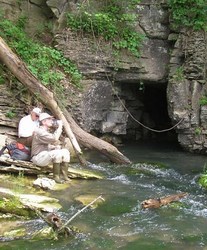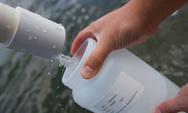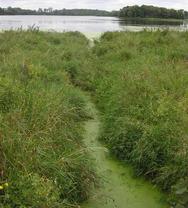|
February 2014
The Basin Alliance for the Lower Mississippi in Minnesota (BALMM) will meet Wednesday, Feb. 19, from 9 a.m. to noon at the Minnesota Pollution Control Agency (MPCA) office in Rochester at 18 Wood Lake Drive S.E.
Agenda as follows:
- 9 a.m. - “Geologic Controls on Groundwater and Surface Water Flow in Southeastern Minnesota and its Impact on Nitrate Concentrations in Streams,” Tony Runkel, Minnesota Geological Survey
- 10 a.m. - Break
- 10:30 a.m. - “Clean Water Accountability Act Requirements,” Gaylen Reetz, Watershed Division Director, MPCA
- 11:30 a.m. - Open discussion on regional topics
- Noon - Adjourn
 At the February BALMM meeting, Tony Runkel of the Minnesota Geological Survey will discuss a three-year investigation by the Minnesota Geological Survey for the MPCA that provides a better understanding of the geologic controls on nitrate transport in the bedrock dominated landscape of southeastern Minnesota. In this study, researchers compiled nitrate concentrations from analyses of both surface water (stream baseflow) and groundwater (springs and water wells) and evaluated samples in the context of the hydrogeologic attributes of the bedrock and surficial deposits depicted on maps. They focused on hydrogeologic controls that can account for variability in nitrate concentrations that do not appear to be adequately explained by land use practices alone.
The results have relevance for management efforts to mitigate nitrate loading. One implication is that the response time of nitrate concentrations to changes in land use practices will likely vary in different hydrogeologic settings. The most significant lagged response should be expected in valleys where significant baseflow derives from deep, siliciclastic-dominated bedrock sources with one or more overlying aquitards, whereas quicker changes in baseflow nitrate concentrations can be expected where the geologic setting allows only a relatively minimal contribution of regional flow.
Also important is the recognition that contaminants will be transported to progressively deeper aquifers and are likely to increase in concentration with time, assuming nitrate input from the land surface does not decrease in the future. In part this is because relatively old water that serves to dilute contaminant concentrations is a finite resource that is diminishing with time.
Photo above shows Odessa Spring in southeast Minnesota, where springs and underground rivers are common in the bedrock-dominated landscape.
|
 What exactly does the Clean Water Accountability Act mean for state agencies and local partners? Gaylen Reetz, Watershed Division Director for the MPCA, will speak at the BALMM February meeting on this Act passed by the 2013 Minnesota Legislature.
Since voters approved the Clean Water, Land and Legacy Amendment in 2008, the MPCA and other agencies have more funding for water quality. Making the agencies and others more accountable for that funding and its goal of clean water, several environmental groups successfully lobbied during the 2013 legislative session for a bill referred to as the Clean Water Accountability Act. Through the legislative process much of this bill became part of the Clean Water Legacy Act.
|
This new law aims to ensure that state reports are more specific in identifying all sources of pollution, that state agencies target funding where it can have the most benefit, and that the state reports to the public on its progress toward clean water goals.
This new law defines a fairly new approach by the MPCA called Watershed Restoration and Protection Strategies (WRAPS). Over the past few years, the agency has worked to implement a watershed approach to protecting and restoring lakes and streams. Whereas previous studies (Total Maximum Daily Loads or TMDLs) and accompanying implementation plans often focused on a limited number of impaired lakes and/or stream segments, studies now look watershed-wide and include protection considerations for unimpaired waters.
With the watershed approach, the MPCA can assess the state’s waters more efficiently, saving money and time. The MPCA is currently on track for monitoring all of the state’s 81 major watersheds by 2017 and completing TMDLs and WRAPS for those watersheds within the next 10 years. The agency is also collecting more data, informing local plans and decisions, and producing a watershed plan that goes beyond the TMDLs to include timelines for actions.
Under the new law, WRAPSs must include the following:
- A precise assessment of pollution sources and needed reductions, including those from nonpoint sources
- Timelines and milestones for assessing progress
- Strategies to put the money where it will have the best result
- A plan for effective monitoring
The act also requires the state to develop the following:
- Biennial reporting by the MPCA of progress in achieving pollution reductions
- A nonpoint priority funding plan by the Minnesota Board of Water and Soil Resources
 The Whitewater River Watershed in southeast Minnesota (photo at right) is one of four pilot watersheds for the Minnesota Agricultural Water Quality Certification Program (MAWQCP), which is now enrolling farms. All producers that farm within the four pilot areas are eligible to participate. In addition to Whitewater the other three watersheds are:
- Elm Creek in Faribault, Jackson, and Martin counties;
-
Middle Sauk River in Stearns County; and
- Whiskey Creek in Otter Tail and Wilkin counties.
This new voluntary program is designed to accelerate adoption of on-farm practices that protect Minnesota’s lakes and rivers. Producers who implement and maintain approved management practices will be certified and in turn obtain "regulatory certainty" for a period of 10 years. Under the program, a farmer demonstrating the implementation of best management practices to protect water quality receives a 10-year certification and will be regarded as meeting any new targeted reductions and water quality regulations that occur in those 10 years.
The goal of the three-year pilot is to gather feedback from local farmers and partners in order to refine and improve the certification process.
Local advisory committees have been established in each of the pilot areas to ensure this program meets the needs of farmers in different geographic regions. These committees were formed in 2013 and held their first meetings early this year.
Local technical staff members are now working with farmers to assess their operations for certification. These assessments are conducted with an assessment tool that is customized for this program. This tool evaluates individual farm fields in the following categories: field characteristics, nutrient management, tillage management, pest management, irrigation and tile drainage management, and conservation practices. This provides valuable agronomic information to farmers; it also supports focused conversation and is a critical educational tool.
For more information, please visit the program webpage. In the Whitewater area, contact the Whitewater River Watershed Project at 507-523-2171 or www.whitewaterwatershed.org.
|
 Nearly all of Minnesota’s 81 major watersheds are benefitting from projects supported by the Clean Water Fund, as established by the Legacy Amendment in 2008, according to a recent report. The majority of that funding – 84 percent – is going toward implementation activities. And local partners play an important role as 43 percent of appropriations were awarded to non-state agencies.
State agencies that receive Clean Water Fund dollars released their second collaborative report this past week. The report clarifies connections between the Clean Water dollars invested, actions taken and outcomes achieved. Money in the Clean Water Fund comes from the Clean Water, Land and Legacy Amendment that Minnesotans passed in 2008. Until 2034, approximately $85 million each year will be invested in various water management activities.
The 24 measures in the report provide a snapshot of how Clean Water Fund dollars are being spent and the progress that’s been made. The measures are organized into four categories: investment, surface water quality, drinking water protection, and new this year, external drivers and social measures.
External drivers provide context for changes in water resources over time; social measures are being created to track how Clean Water Fund investments affect people and communities, specifically their ability to support and participate in local water projects. These measures are part of a larger set that will be used to consistently track and report clean water outcomes over the life of the amendment.
The 2014 report includes six new measures this year:
- Watersheds monitored by local partners;
-
Source water protection grants;
- County geologic atlases;
-
Long-term monitoring network wells;
- Unused groundwater wells sealed and
-
Groundwater levels.
Each measure has a status ranking and trend information. Of the 24 measures, status and trends vary:
- 11 measures showed improving trends;
-
Four showed no trend or were too early to assess;
- Two showed a declining trend; and
-
The report does not include trend information for investment measures
“We understand that people want to see immediate results from Clean Water Fund investments,” said Rebecca Flood, Assistant Commissioner at the Minnesota Pollution Control Agency. “However managing Minnesota’s water resources is a long-term endeavor that will take the efforts of many – from state agencies to local governments to citizens.”
View the 2014 Clean Water Performance Report on Minnesota Legacy’s website.
|
 The MPCA has extended the public comment period for the draft TMDLs for Upper Cannon Lakes to Feb. 17-March 3.
Reducing nutrient levels is the focus of water quality studies for the Jefferson-German chain of lakes and Lake Volney in south-central Minnesota. These lakes drain to the Upper Cannon River, a major tributary to the Mississippi River in Minnesota. Nutrients such as phosphorus are problematic because they can fuel algal blooms and make lakes less suitable for recreation.
View the draft reports online by going to the MPCA website and searching for “Upper Cannon lakes.” The deadline for comments, which must be in writing, is 4:30 p.m. on March 3. Submit comments to Shaina Keseley, MPCA, 18 Wood Lake Dr. SE, Rochester, MN 55904; phone at 507-206-2622 or 800-657-3864; or email shaina.keseley@state.mn.us.Written comments must include a statement of your interest in the reports; a statement of the action you wish the MPCA to take, including specific references to sections of the draft reports you believe should be changed; and specific reasons for your position.
|
Spill of 12,000 gallons of crude oil from train car:
Federal farm bill:
Silica sand issues:
Silica sand website: Upcoming meetings, comment opportunities and more
Interested parties can find the latest information on the state’s role in frac sand issues with the “State of Minnesota Silica Sand Information” website. The website includes public notices, rulemaking meetings, advisory panel information, and contact information. The Minnesota Environmental Quality Board maintains the website.
You can also sign up for email updates about “Rules Addressing Pollutants from Silica Sand Projects” on the MPCA website. Look for the “Email Alerts” icon in the upper right corner.

News you can use: Video series on watershed approach to caring for state’s resources
The MPCA recently released a four-part series on the “Watershed Approach,” a relatively new process for gauging the health of Minnesota’s waters and taking action to protect or restore them. The series covers:
- Part 1 – What is a watershed?
- Part 2 – How we got where we are
- Part 3 – The watershed approach and 10-year cycle
- Part 4 – Getting involved in the process
This series is a great tool for introducing citizens and volunteers to local watershed work, for opening public meetings on watershed projects or for sharing with students.
|
Kathryn Jones and Dave Johnson, of HDR, Inc. will discuss Envision, a certification program that holistically evaluates the community, environmental, and economic benefits of infrastructure projects -- including water systems – at the upcoming Mississippi River Forums. They will speak Friday, Feb. 21, from 8-9:30 a.m. McKnight in Minneapolis and Friday, March 21, from 8-9:30 a.m. the St. Cloud City Council Chambers. There is no charge for the forums, which include a light breakfast, but an RSVP to Lark Weller of the National Park Service is required.
Dr. Emily Stanley, limnology professor at University Wisconsin-Madison, will speak about "Lessons from the long view: challenges and opportunities with long-term research in aquatic ecosystems" at the 46th Annual Meeting of the Mississippi River Research Consortium. The meeting will be held April 23 – 25 at Lacrosse Wis. For details, visit the consortium website.
BALMM would like to highlight your projects and events. For submission guidelines, please contact Donna Rasmussen, BALMM Chairperson, at the phone number or email below.
No longer interested in receiving BALMM Currents? Please click here to change your subscription preferences or click on the “unsubscribe” button below.
Thank you,
Donna Rasmussen
Chairperson, BALMM
Administrator, Fillmore SWCD
900 Washington St. NW
Preston, MN 55965
donna.rasmussen@fillmoreswcd.org
507-765-3878, ext. 3
Shaina Keseley
BALMM Coordinator
MPCA - Rochester
shaina.keseley@state.mn.us
507-206-2622
|